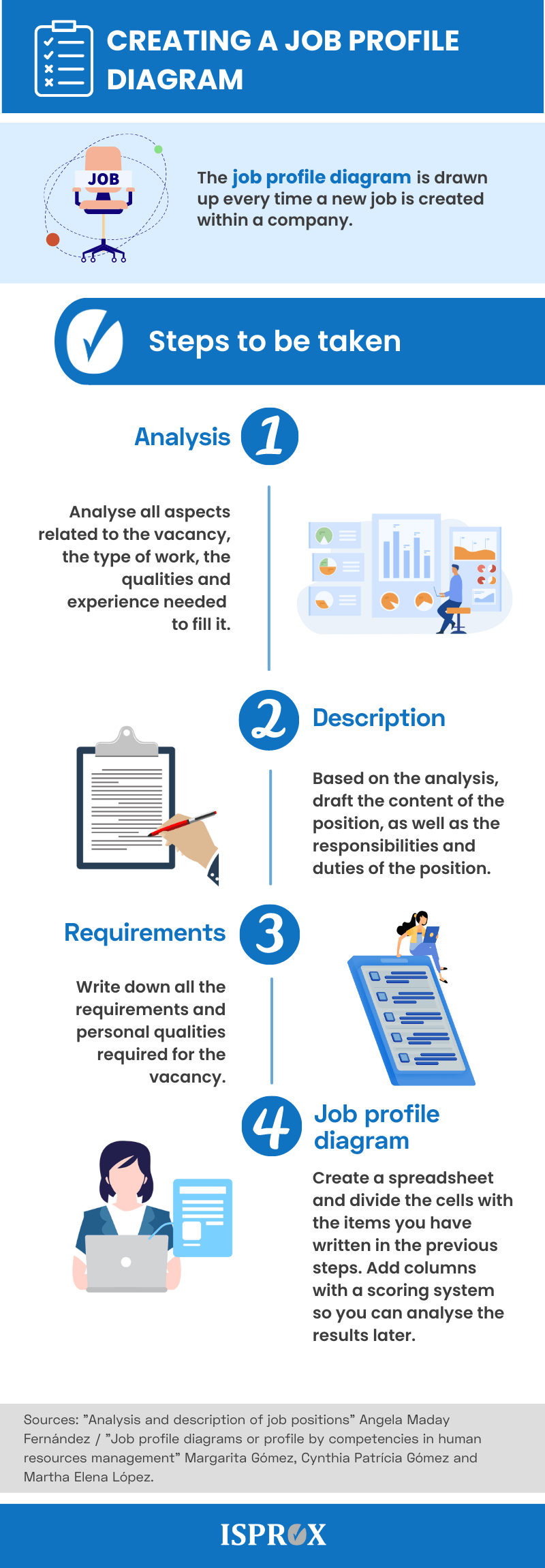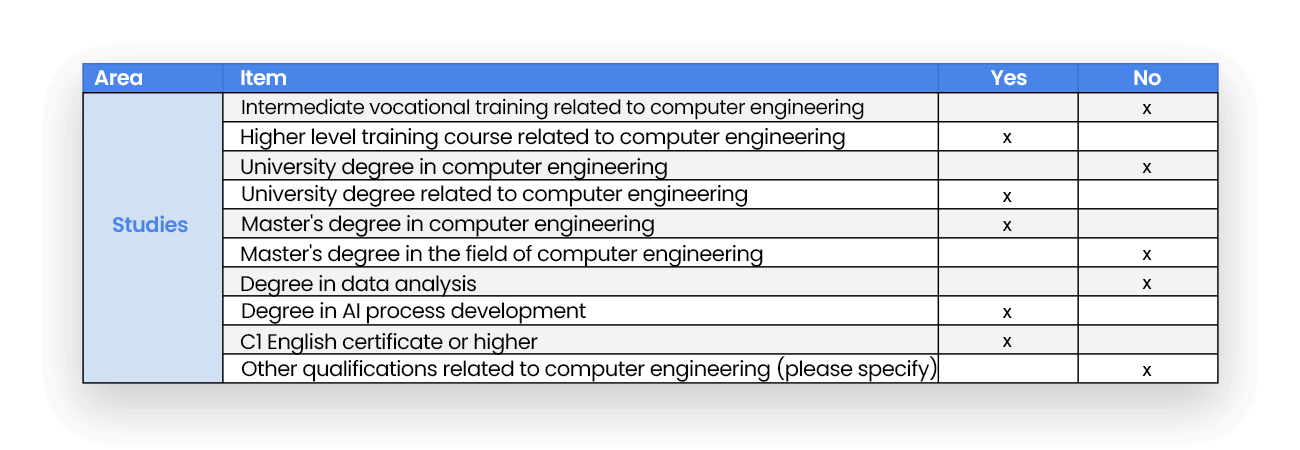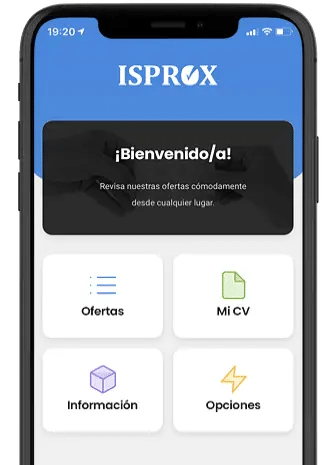You have an interview with a candidate in 10 minutes. You have made a quick list of the job specifications and the questions you will ask. Once the interview is over you realise that you skipped an important question or forgot to check something relevant to the vacancy, so you spend more time chasing down the candidate with calls and emails to get the missing information.
Then it’s time to compare the notes you made during the interview with the notes you made during other candidates’ interviews and you get lost among the different answers and new revisions of their CVs. Has this ever happened to you?
If you are now wondering how useful a job profile diagram is, we can tell you that it can save you unnecessary chasing and allow you to optimise the time you spend on interviews and candidate selection. In this article we tell you in detail what it is, what it is for and how to create yours in 6 steps.

What is a job profile diagram and how is it useful?
A job profile diagram is a graphical or tabular representation of a job profile. This document is responsible for grouping, in a summarised form, the organisation of a job position, as well as the skills and aptitudes required to perform that job.
It is a very useful tool in the area of human resources, since it allows the recruiter to visually identify the characteristics that a candidate should have. It also allows you to be objective and avoid discriminatory biases, as well as to be very clear about what you should look for in each candidate.
What is the purpose of a professional profile?
When you are managing a vacancy but don’t know exactly what to look for, it is inevitable to get a bit overwhelmed, so the first step is to define the candidate’s profile and the search criteria correctly. When you want to recruit the right talent for the job you are looking for, you need to do a thorough research and analysis.
If you don’t want to get bogged down in the selection process and you want to find the ideal profile more quickly and with a guarantee of success, we recommend that you go to a consultancy specialised in recruiting talent so that they can draw up a suitable job profile diagram and carry out the entire recruitment process for you.
Are you looking for talent to expand your team?
At ISPROX we help you find the right profile, saving you time and increasing your hiring success rate.
In this way, a job profile diagram provides a system for accurately defining a job position and assessing whether candidates are close to or far from this definition. All those that come closest to the profile will be selected, thus achieving a higher productivity in the process.
This tool is not only used to evaluate profiles according to their performance, but also to see whether or not the candidates that are presented adapt to the company’s values. In fact, with the job profile diagram you can establish the criteria you want, you just have to include them in the graph or table and assign a value, as we will show you later on.
On the other hand, this document allows the selection to be more objective, eliminating criteria guided by gender, age, nationality… This can also be included in the company’s values, as well as in the equal opportunities plans for all candidates who have a suitable profile for the position.
Types of job profile diagrams
Job profile diagrams can be divided into two types, depending on the search you want to do:
- Job profile diagram by factors: This includes all the characteristics of the job, both physical and psychological or personality aspects, as well as the skills that are essential to perform the different tasks required for the job.
- Competency-based job profile diagram: This is more frequently used in selection processes and focuses on establishing the skills and knowledge of the worker.. This type of job profile also allows you to determine whether the candidate will be able to apply his or her training to solve potential problems in the workplace.
Now you may be wondering how to create a job profile diagram. Here’s how to create one from scratch.
How to create a job profile diagram
Before you start, keep in mind that the job profile diagram is not a closed document. It has to be adapted to each selection process and to the interests or needs of your company. Therefore, the length of the job profile will vary depending on the job to be filled. If the job profile is very complex, your job profile diagram will have more items.
In general terms, when drawing up this document, you should be clear about the points that make up the analysis of the profession and detail the characteristics that the candidate must have to fill the vacancy offered.
We recommend that you create it in a spreadsheet, as this tool will make it easier for you to establish metrics and compare candidates. Once you have defined the sections and sub-sections to classify the characteristics of the ideal candidate, you will have to establish the scoring methods that best suit you for each one (grades, levels, scores…).
Here are 6 steps to follow to create your job profile diagram:
1. Dividing up the duties
First of all, you have to divide and define all the duties that will be required to perform the job offered, assigning to each one the competency required to perform it. For example, if the position is a product design engineer, you could add tasks such as “design of machinery and manufacturing parts”, “preparation of material lists for purchase/ manufacture”, “preparation of technical documentation”, “on-site visits to installations”, etc.

This involves listing all the duties to be performed in the job in a table and leaving a few cells free to mark the ones that the candidate would be able to perform.
2. Describing education and training
Write in the document all the studies, qualifications, knowledge and skills that are required, you can also think about which ones could be a plus.
For example, if the offer is for a bilingual computer engineer, the values to take into account in this section could be: having a degree in computer engineering, degrees related to data analysis or AI process development, a master’s degree in computer engineering and even English language qualifications. In this case, a degree in data analytics would be a plus.

3. Listing soft skills
With the job position in mind, make a list of all the soft skills that the candidate should have. For example, if the vacancy is “project leader”, the candidate should be proficient in communication and demonstrate leadership skills, such as the ability to motivate and manage a team, patience, etc.

4. Determining levels of experience
You should determine what levels of experience are necessary for the successful applicant to perform the job offered; whether they need to have experience in the sector or simply in a position with similar duties.
For example, if the vacancy is for a sales manager position, you can add different boxes in the document where you can determine whether their previous jobs are similar or not to the position offered. In this section we recommend that you leave a blank space so that you can write notes such as the names of the jobs you have held.

5. Personality aspects
In this case you must be very clear about the psychological profile of the candidate. We are referring to such personal aspects as sincerity and initiative, which will vary greatly depending on the position offered. Make a list of all the personality traits that the ideal candidate should have, and next to it two columns to indicate whether he/she has them or not.

6. Other
Depending on the vacancy, you may need to include other items such as promotion opportunities or personal development options. If, on the other hand, the job offer has more specifics, such as a requirement to travel abroad or work remotely, then you can add them here.

Why is it useful to have a job profile diagram?
You will optimise the search process
They say that time is money and with this tool you will be able to drastically reduce your time invested in the selection process. Thanks to the process of creating a job profile, the company will be able to create the model of the applicant it is looking for.
In this way, not only will the advertisements of the vacancies you manage be clearer and more effective, but the selection process will be more dynamic and precise, as you will have all the necessary information at hand to determine whether or not the candidate meets the requirements of the profile, and to draw up a ranking of candidates through the scores obtained in the most important metrics.
You will reduce the turnover rate
Finding the ideal person means that the new employee will not only be professionally suitable to carry out all the tasks required for the position, but will also adapt perfectly to the already established team, culture, values and, in short, to the company as a whole.
This will significantly reduce the likelihood that the new employee will leave, because if the job profile diagram and the selection process have been done correctly, his or her values and interests will be aligned with those of the company.
In summary, we could say that the job profile diagram is a very useful tool to assess the level of suitability of an employee or future employee for the job, and thus achieve greater performance and productivity of the human resources department in the company. Have you implemented it in your selection processes?










